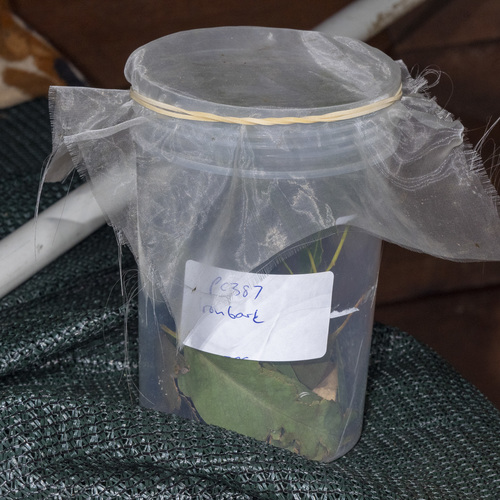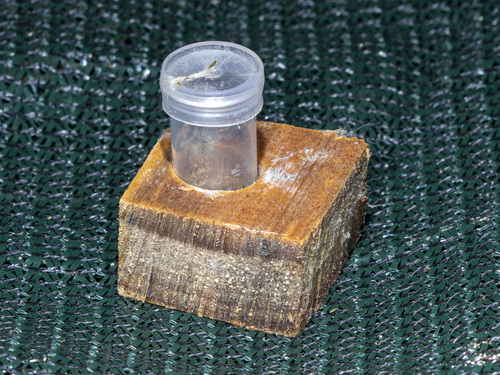Introduction
I am basically an amateur naturalist, although I do have qualifications and experience in Environmental Management I don’t work in that field. I have been an Environmental Volunteer for many years and one of my passions is Tarra-Bulga National Park. An interest in identifying and monitoring flora, fungi, birds and mammals developed over the years and I have now continued to develop an intense interest in insects and other invertebrates.
How did you get interested in rearing caterpillars?
After five or so years of putting up a light at my home (and other places) to survey moths and other insects, I began to think more about the whole life cycle of the moths I was finding. It became apparent to me that Moth species are described as adults, for many species there is no records of what their larva look like and many other aspects of their biology and life cycles remain unknown. I was taking pictures of caterpillars that I found and for many even identifying them to family level was difficult. I saw that a few amateurs were obviously successfully rearing moths, so I thought why not have a go myself.
Why is rearing caterpillars interesting/important to you?
Caterpillars are a very important part of ecosystems, but as I have already mentioned we really don’t seem to know much about them. I also just find the whole process fascinating to observe and document. Some species of caterpillars look amazing, and they make brilliant subjects to photograph. It is also quite a challenge to rear some species and it can be an elating experience to find a newly emerged moth or butterfly that you have successfully nurtured, especially when it is a species that no one to your knowledge has ever successfully reared before.
Where do you find the caterpillars you rear?
To date almost every caterpillar I’ve raised has been found on my property. The property adjoins a large tract of State Forest and I have also planted my property extensively with a diverse range on indigenous vegetation. Hunting for caterpillars with a torch or headlamp at night can be a good way to find them but using a beating net can be successful and others I find when weeding my garden. I have in some cases raised moths from eggs that I have found on leaves. I have also taken female moths off my light sheet and placed them in a container for them to lay eggs to raise. I would like in future to rear species found in one of my local National Parks, but to do that I would need a permit to collect any specimens or plant material required. I would also need to work out how I was going to keep the larvae supplied with fresh plant material for species I don’t have growing at home.
What sort of containers/set up do you use? Photos?
These days I use plastic containers which I have brought online. They are tall plastic ones with screw top lids. I have a range of containers 600ml, 1000ml and 1800ml. In place of a lid, I use a rubber band to secure a square of fine insect mesh over the top. Inside the container I usually use a small plastic floral tube in a home-made holder as a way of keeping the food plants fresh for longer. Sometimes I put peat mixed with sand in the bottom of the containers. This can be good for species that like to burrow, and some species prefer to pupate in soil. I do find having medium in the bottom of the container can make it harder to locate you larva and also makes it harder to clean out any droppings (frass). I usually put a twig in the containers after the pupa has formed, this can provide a place for newly emerged adults to perch when they stretch out their wings.


What do you feed the caterpillars - how do you know/guess what they'll eat, and where do you find the food plants?
If I am raising a caterpillar that I have found I usually feed it the species that it was found on. Or in some cases (e.g. if it wasn’t found on a plant) I try some of the common species growing nearby. I have not had much success at raising Lichen Moths but at least now realise that I need to be finding suitable lichens for them to feed on. https://australian.museum/learn/animals/insects/lichen-moths-from-insects-website/ I have also had only limited success when raising caterpillars from eggs. Some species e.g. Uraba lugens (Gum leaf skeletonizer) are easy but for others I have found it is difficult to find what new larva like to eat. Recently for some species I have added thin slices of apple and rose petals which are known as universal foods that many species will feed on. You can often get an idea of what a preferred species might be from using references such as http://lepidoptera.butterflyhouse.com.au/moths.html or the Moths of Victoria books, as well as books like McQullian et al (2019) and Coupar & Coupar (1992).
How do you keep track of your caterpillars?
When I started to raise caterpillars, I used collapsible mesh cages and I was adding multiple larvae of several different species in the one cage. I learnt eventually that it was impossible to keep track of individuals this way. I realised that the only way to track things properly was to use smaller containers with only one caterpillar. Sometimes if I am rearing species from eggs, I will have lots of caterpillars in the one container, in these cases I can only make my observations of the group rather than individuals. Each container I use is labelled with a code number. When I take photographs of the container contents, I take a photo of the label first. On my computer I can then work out which photos came from which container.
How do you photograph the lepidoptera - how often? - what camera?
I try and take a photograph of each container I have every third day (at the same time as I freshen up their food plants). If I am in a rush, I use an Olympus compact digital camera (TG-6) which has an excellent macro mode. For higher quality shots I use a Pentax DSLR with a Macro lens and flash. The flash is important as that way I can use a smaller aperture and get more of the caterpillar in focus. I crop all my photos with a photo editor before adding them to iNaturalist. This is to make sure that all the detail is as clear as possible.
What additional data do you like to collect for each rearing?
I have limited time to do my caterpillar raising so I tend to rely on the photographs for my record keeping. I do label the foodplant used on the container, this helps me remember what to feed it. When I upload results on the iNaturalist I go through the photos and use the photo dates to add the dates for hatching, pupation, emergence etc. As well as anything interesting about the way they formed their pupa. If I had more time, I would take length measurements of everything as they develop and take notes on other aspects of their activity and behaviour.
Anything else e.g. temperature/humidity considerations? Anything you've learnt along the way from successes and failures?
I have learnt a lot since starting out. Controlling humidity has certainly been a learning curve. When I first started using containers it was winter and I found that you could get away with having a plastic lid on the containers and everything would stay quite nice. I found that in springtime however lack of ventilation and higher temperatures meant condensation build up and problems with mould developing, so I quickly switched to having fine mesh lids on all my containers. Keeping containers moist is more of a challenge in summer. I did not realise that Pupa need some moisture to survive, and I think I killed quite a few Pupae last summer because I let them get to dry. I now use a spray bottle to increase the humidity if things have gotten a bit dry. I keep my containers under a veranda that protects them from direct sunlight. I have also learnt that you need to be careful when handling your caterpillars. Unfortunately, when I have gotten a bit rushed or careless at times some have been accidently squashed or have managed to escape from their containers. Some of them can be quite fragile.





